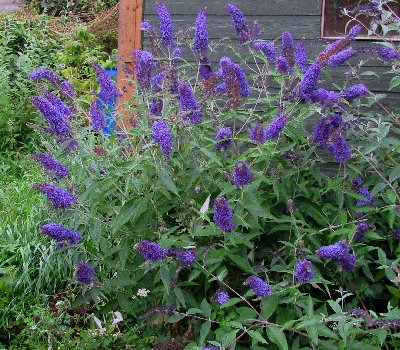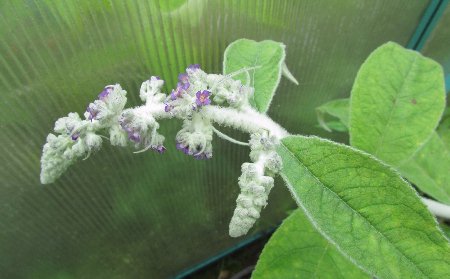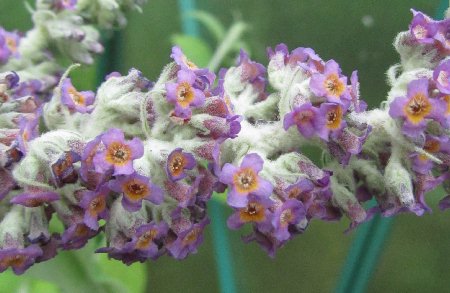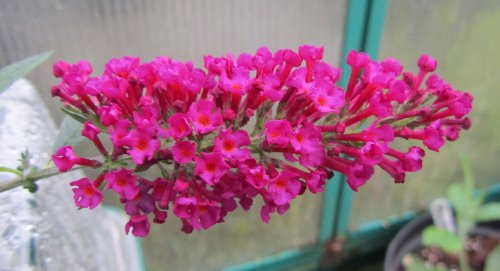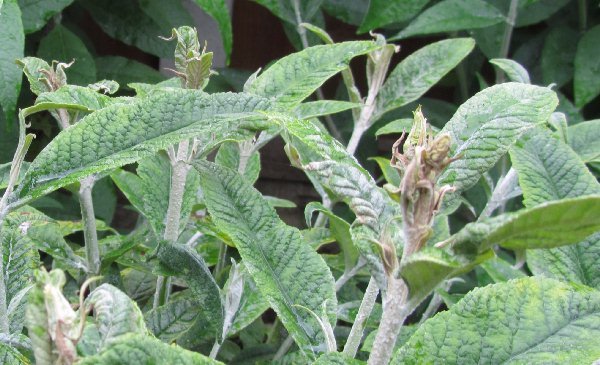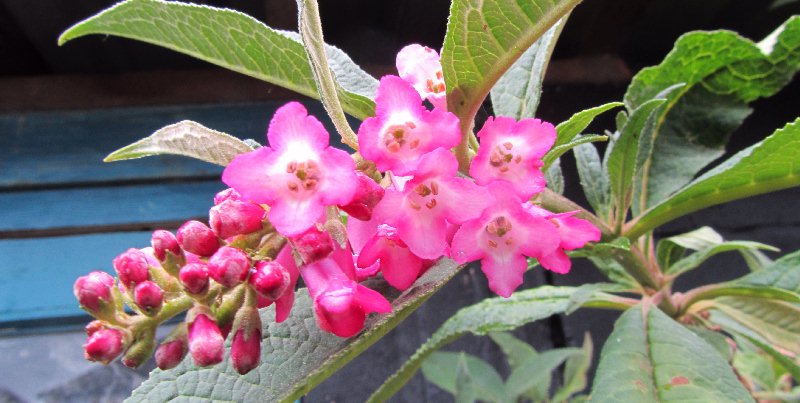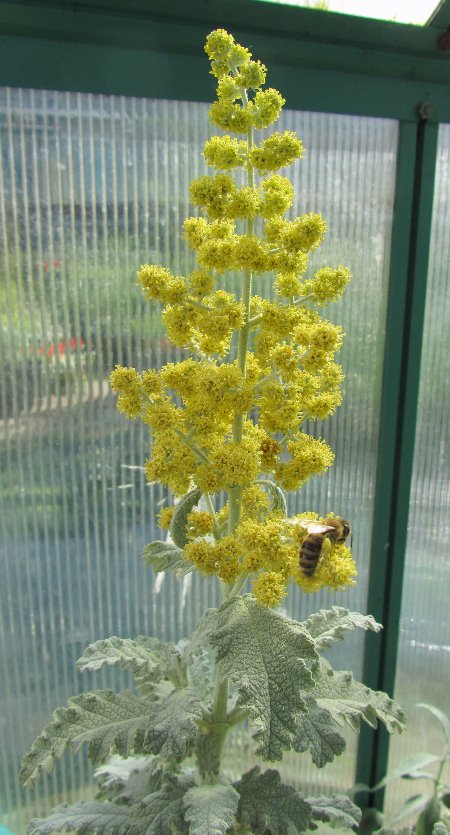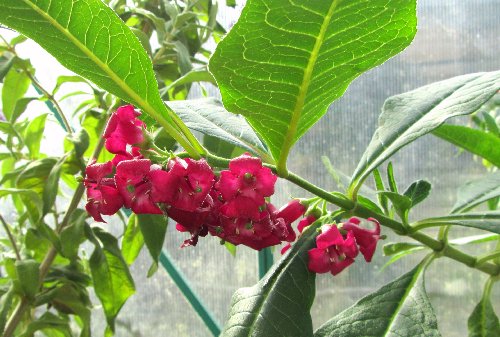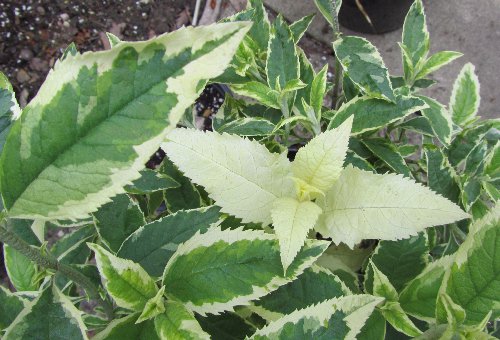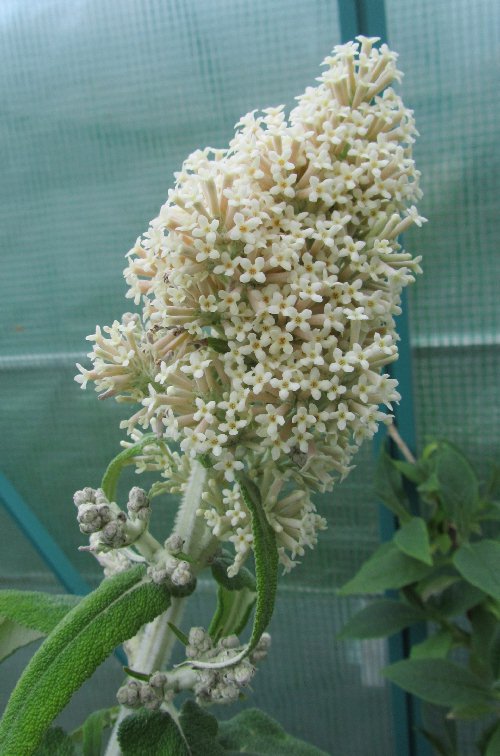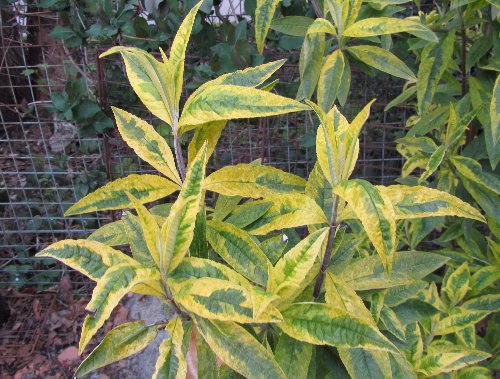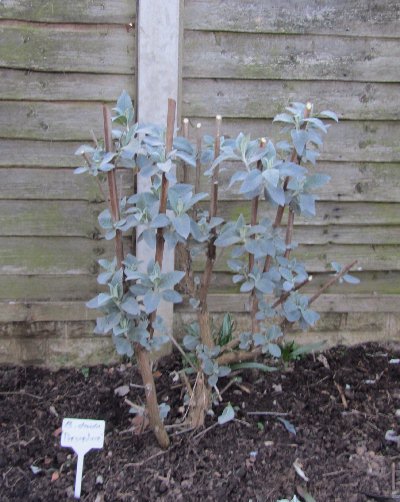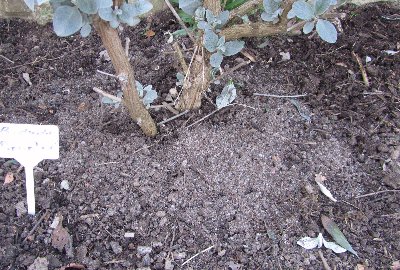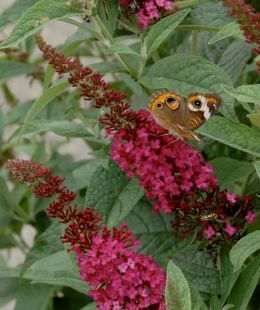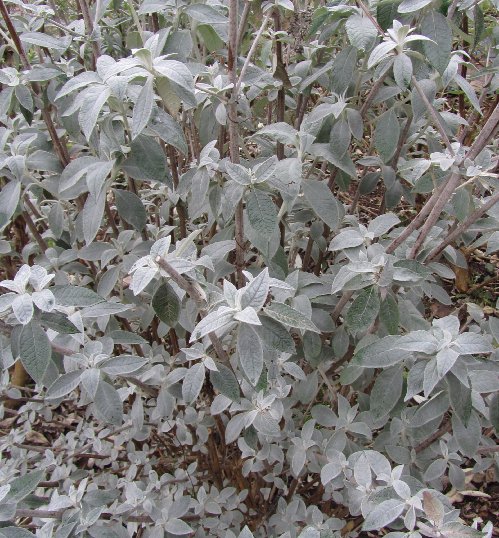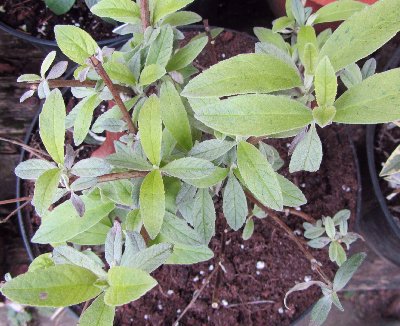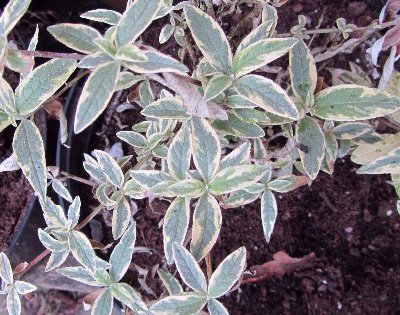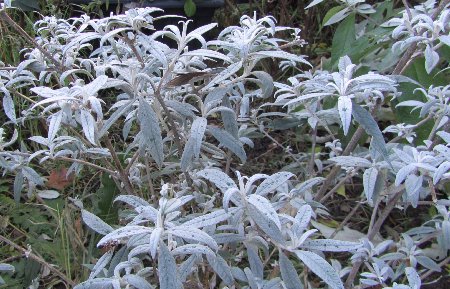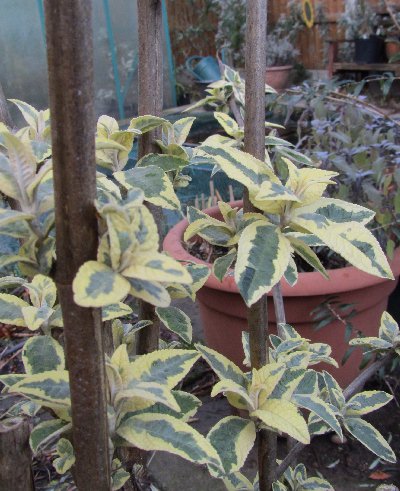
The 2011/2012 Buddleja Calendar
October 2012
|
Autumn is well under way and we can now look forward to winter in a month or two. A few B. davidii flowers persist and there are still quite a few B. x weyeriana blooms to attract the late butterflies. Red admirals, small tortoiseshell and commas are still actively feeding if the sun is out. Many species Buddleja flower later in the year than B. davidii. One of my favourites is B. auriculata , or Weeping Sage as it is called in South Africa where it comes from. This species has small, dark green glossy leaves and bunches of tiny white flowers with a very pleasant scent indeed. Potentially it can form a large shrub but is unlikely to so in England. I had one of these a couple of years ago that I planted against a sheltered south-facing wall believing it to be fully hardy. It was dead within days of the snow falling in the harsh winter of 2009-2010 so I guess it isn't quite as cold tolerant as I thought. I have a new one now in a pot, in a greenhouse. Before risking this one I will grow several reserve cuttings. |
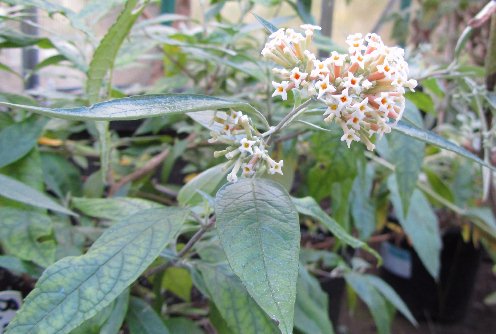
B. auriculata is an fine species from South Africa. |
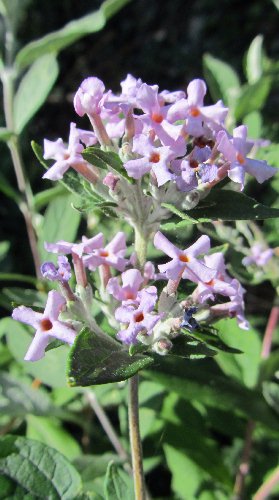
B. caryopteridifolia, flowering now. | B. caryopteridifolia is also flowering now although it can do so in the spring as well if conditions are right or it has been kept under cover for the winter. It is described as fully hardy which I will try to confirm as I have planted mine outside now. Bear in mind that it can look dead during the winter because it is fully deciduous, but it sprouts back to life in the spring. B. officinalis is usually late winter flowering (February) and is another one that I wouldn't risk outside unless I had a really sheltered, warm garden. Curiously, the flower buds are forming now. Last year it did this also and I brought the plant into the house to over winter. Which was a disaster as the buds all died, as the plant nearly did itself. Some Buddleja flower buds form now but stall until the days get longer in the spring, for example B. salviifolia (see below). I am hoping this will be the case with B. officinalis but this year it will spend the winter in a cold greenhouse. |
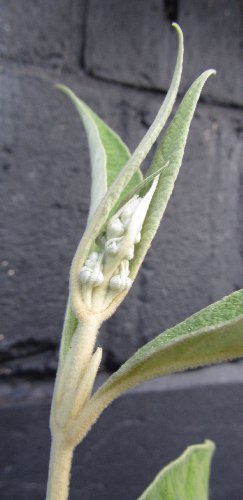
B. officinalis has formed flower-buds now but will they stall for the winter or rot off?. |
Buddleja Longstock Pride (B. lindleyana X B. crispa) is also a consistently late bloomer. Leaves like (B. lindleyana , flowers like neither parent and a scent equal to B. crispa it has proved a reliable, hardy and attractive hybrid. Buddleja Salmon Spheres (B. globosa X B. crispa ) is a confusing plant that can't make up its mind when to flower. This year it started in September, last it flowered intermittently all through the spring, summer and autumn. Nobody seems to know how hardy it is so I have planted one outside and kept a reserve under cover. |
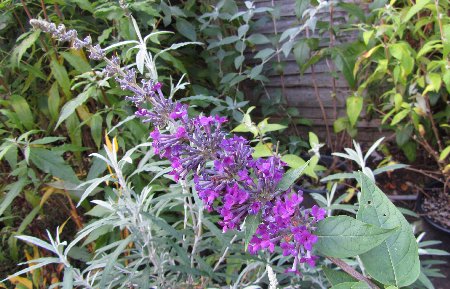
'Longstock Pride'. |
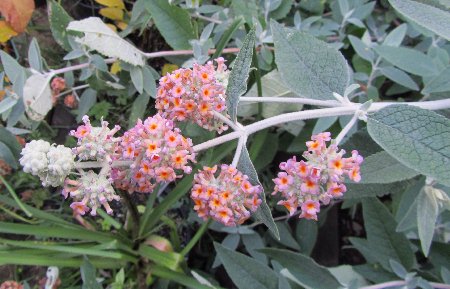
'Salmon Spheres'. |
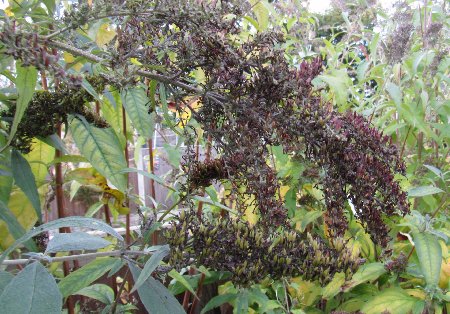
Best to remove the messy seed heads before the winter.. | There are jobs to do this month. The more tender Buddlejas (like several above) in pots need to be put in a dry greenhouse until next spring. Wet is the killer so keep the compost relatively dry for most species, water only if there are signs of dehydration stress. Dead-heading B. davidii is essential if you want to be a good neighbour as each shrub can produce several hundred thousand seeds. It also looks tidier as the seed heads are rather ugly. If you are keeping seeds they probably need to be left another month to fully ripen. I also usually reduce the height of my plants by about a third to reduce the chance of wind rock and also to encourage buds to form lower down on the plant. This is not the annual pruning, which should be left until March or even April. So that is the year in The Buddleja Garden and the calendar is taking a rest until spring next year as there is not much doing over the winter. Check back often as I am updating some of the other pages. |
September 2012
|
Autumn is here but many Buddlejas can still be in flower. It can't be overemphasised how important these late flowers are to both butterflies and bees. Butterflies need to stock up before hibernating or migrating. Both bees and the butterflies that over-winter here will emerge on warm late autumn days to feed and welcome the nectar-rich Buddleja flowers. The B.x weyeriana hybrids stay in flower well into the autumn and there is something about the mellow light at this time of the year that brings out the best in the yellow flowered types. |
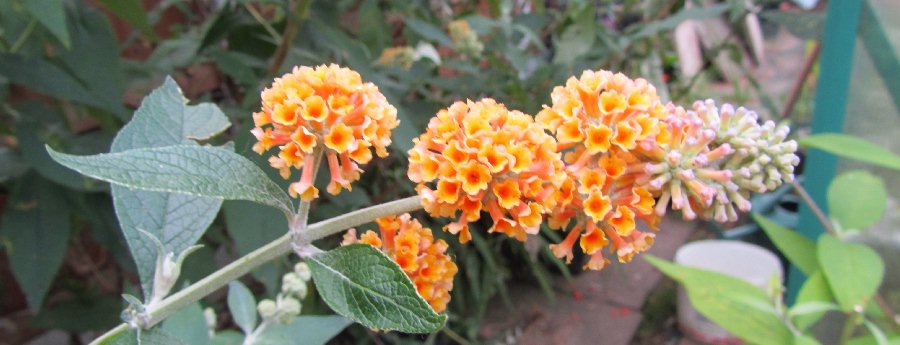
The warm light of autumn accentuates the colours of B.x weyeriana 'Golden Glow'. |
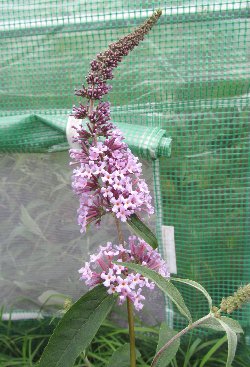
Buddleja 'Autumn Beauty' flowers much later than B.davidii. | Buddleja 'Autumn Beauty' is a bit of an enigma. This plant was discovered near Beijing by butterfly enthusiast Clive Farrell and, despite being relatively rare in cultivation, goes by many names: Clive Farrell; Autumn Beauty; Beijing; from Beijing. The status of this Buddleja is debatable. The main feature is the late flowering, starting only towards the end of the summer and lasting to the first frosts. Its flowers are pale lilac and unremarkable. It's not officially classified as a cultivar, variety or sub-species of B. davidii although it looks much the same. Instead it is classified as a Buddleja of unknown taxonomy because some consider it to be a separate species based on late flowering, although it readily hybridises with B.davidii; in fact efforts are underway at Longstock Nursery to breed hybrids of Autumn Beauty that still flower in Autumn but with stronger coloured blooms. Autumn Beauty is the one to plant if you really want to help those pollinators survive the winter and I have a young specimen ready to plant next year. |
Last month I made a throw-away comment about how common branched flowers are in the feral B.davidii population and that the trait is readily passed to the next generation. Some plants produce complex panicles erratically as a response to particular conditions, Blue Horizon being one cultivar that does so. There are also several cultivars which reliably produce branched flowers: Dartmoor is the oldest, a vigorous and ugly plant with a RHS AGM; Grey Dawn needs to establish before you get the wonderful grey complex panicles; Camberwell Beauty is a smaller shrub from the Butterfly Series; Panache has interesting fat flowers but cannot support their weight so looks messy; and Greenways River Dart is a relative new-comer (see below at Longstock). |
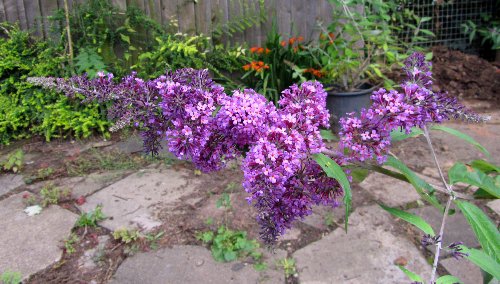
A random seedling with complex panicles.. |
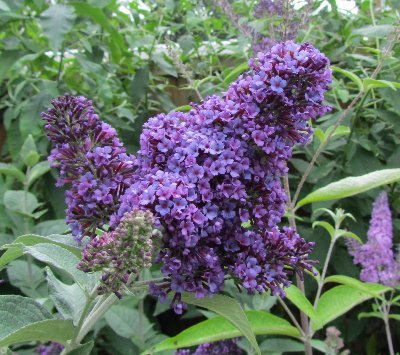
This Panache seedling has fat, branched flowers similar to the parent but on a more upright shrub. | This year I have grown several plants with large, complex panicles. One of these is a random seedling from my own garden with large pink-purple flowers and a different shaped flower to Dartmoor, which it otherwise resembles. I will plant this out next year to assess its potential. I have also grown a number of Panache seedlings from an open pollination. About half of these have branched panicles, sadly many looking as if they have the same laxity as the parent. My aim was to produce an offspring with the same flowers but able to remain upright in flower. At least one is promising although the flowers are a little smaller. |
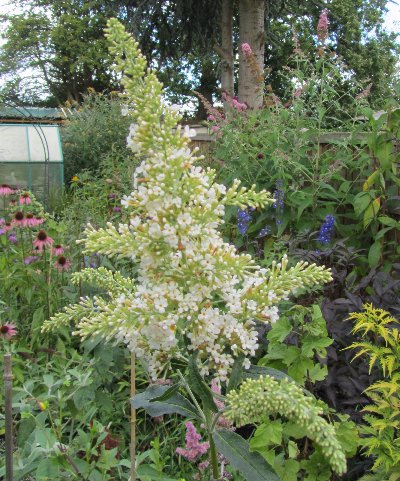
This wild collected plant had branched white flowers but will the cuttings also have this feature?. |
I have also found several of this type growing in the wild. The one I am most exited about is a white example although I have been told others more experienced than me have found similar plants that have failed to come true from cuttings. As this one was growing in a former scrap-yard the appearance could well be due to environment and will not be reproduced in the cuttings, but fingers crossed. | |
Buddleja globosa flowered back in June and the seed pods are ripening. Soon they will be ready to collect if you wish to grow more from seed. It is so much easier to make new plants from cuttings and the seedlings are unlikely to vary much from the parent, so I probably won't bother. |
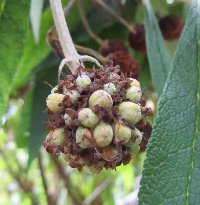
B. globosa seed pods are ripening now. | |
August 2012
Part Two
August is the busiest month for B.davidii and its hybrids. So it seems appropriate to have a second entry for the latter part of the month. We have had some warmer weather but August is ending cold and wet, like most of this summer. I am expecting some casualties come the autumn as many plants have really struggled. It is not only plants that suffer. Many butterfly species will also be knocked back by the cold summer so I was pleased to catch a Peacock on one of my plants. It is an enormous help to both bees and butterflies to keep your Buddlejas in flower for as long as possible. Many butterflies don't emerge until later in August when unpruned plants and those not dead-headed will no longer have any flowers for them to feed on. It was also gratifying to find the butterfly feeding on a new plant I am trialing. This wild collected Buddleja has the palest pink flowers that emerge from dark buds - an unusual and attractive combination. |
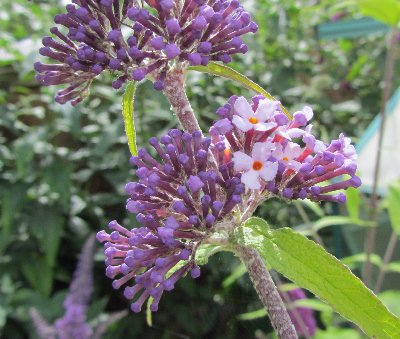
This new plant has very pale pink flowers that come from dark buds. |
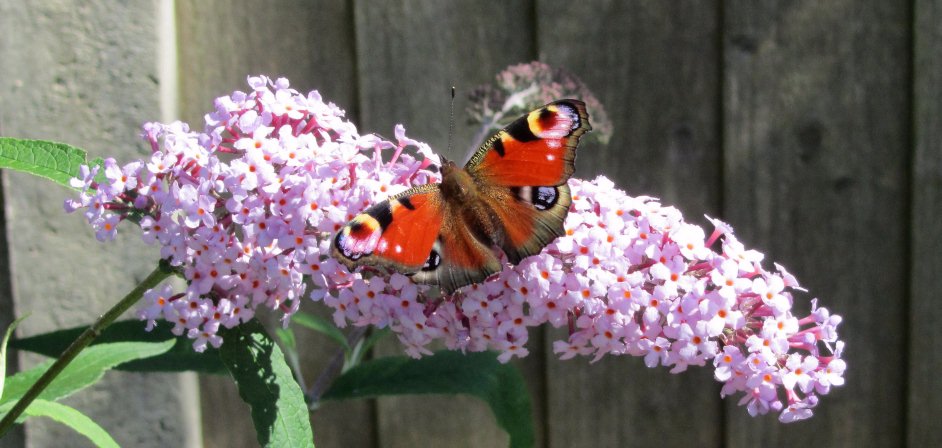
A Peacock on my new pale pink cultivar. | |
Every now and again a plant will throw a 'Sport'. The reasons behind this can be complicated but essentially a change (genetic or epigenetic) occurs in a axillary bud and a shoot with different characteristics grows from the altered cells. This is most commonly seen in variegated cultivars where a branch will revert to green leaves. Camberwell Beauty is a dwarf Buddleja with branched purple flowers and serrated leaves but has a tendency to throw very different shoots. These 'sports' have paler lilac flowers that are unbranched and smooth edged leaves. My theory is that Camberwell Beauty itself was an artificially induced sport and that these are simply reversions to the original form. Just as with variegated reversions these shoots should be removed otherwise are likely to take over the plant. |
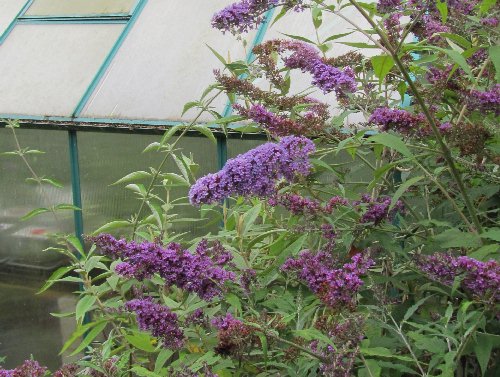
On this Camberwell Beauty the flower in the centre has reverted becoming unbranched and a poorer colour. |
I found a more exiting 'sport' on Les Kneale. This is from the very pale version rather than the pinker one found at Longstock (see below). It also goes some way to explain why there are now two Les Kneales. This flower spike was almost entirely lilac and quite a dark shade. There were a few pale florets to prove that is indeed from Les Kneale. This raises an interesting point about many white Buddleja davidii cultivars. Rather than having a fault in the production of flower pigments (anthocyanins) they carry a dominant gene that suppresses colour production in the flowers called Alb2 (see the reference below). Les Kneale appears to have a weaker version of this gene that allows for a tiny amount of colour to be made, and the pinker version may have acquired a further mutation. However, in much of the flower spike below the suppression has failed completely and a dark lilac colour is the result. At least, that's my theory! (Reference: Tobutt, K.R. 1993. Inheritance of white flower colour and congested growth habit in certain Buddleia progenies. Euphytica 67:231-235.) |
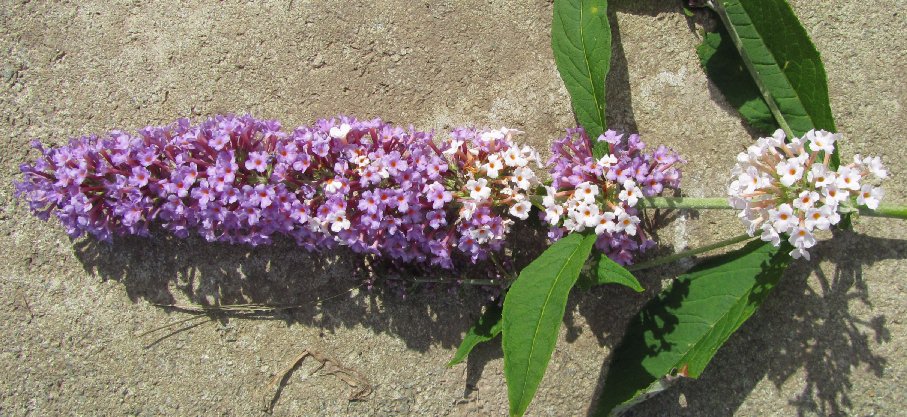 Les Kneale has thrown a dark lilac flower. |
There was an article in the Telegraph this month (and also on-line) about my good friend Andrew Bullock who runs The Lavender Garden and introduces one of his new cultivars. Cotswold Blue is very like his excellent Shire Blue but has much darker flowers with a really intense red eye. He was kind enough to let me have a plant to try last year and it has really performed well this year. Cotwold Blue will be released in 2013 and initially be only available from The Lavender Garden.
|
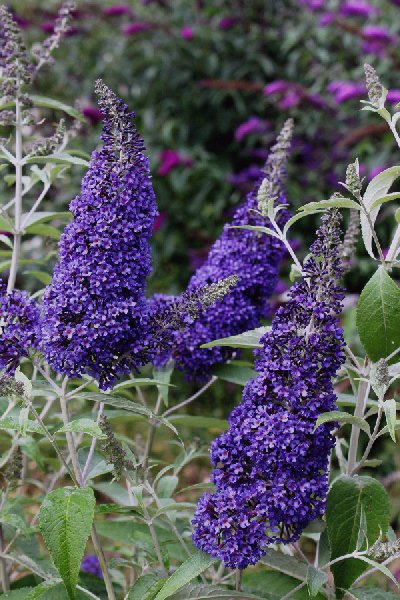
Its deep blue petals are complemented by a small red eye. (Photo from The Lavender Garden.) |
August 2012
A Visit to the Longstock Park National Collection
It is always nice to get out and about in the summer when it finally arrives. We are lucky in England to have two excellent Buddleja National Collections that are open to the public and completely free. The Lavender Garden (Gloucestershire) and the Longstock Park Nursery (North Hampshire) are great places to see Buddlejas and maybe buy a plant or two. I have visited The Lavender Garden many times and finally got to Longstock Park earlier this month where I was shown around by renowned Buddleja breeder and collection curator Peter Moore. So I thought I would share some of the treasures spotted there. The first thing that caught my eye was B.x weyeriana Variegata, a sport of Sungold with yellow flowers. I have never seen this before and was surprised to find that the variegation is in the form of random yellow blotches rather than at the leaf margins. The level of yellow is quite variable over the Longstock specimen and is an aquired taste as it looks a bit like the spidermites have been at it. Personally, I like it. |
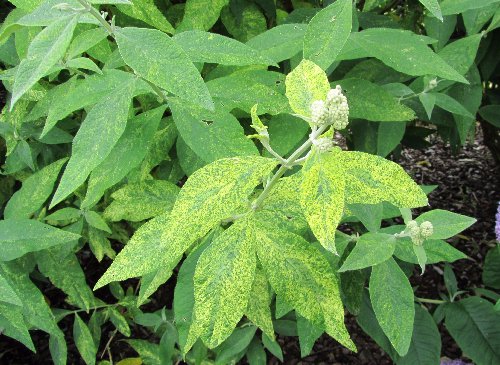
B.x weyeriana Variegata has splotched and variable yellow variegation. |
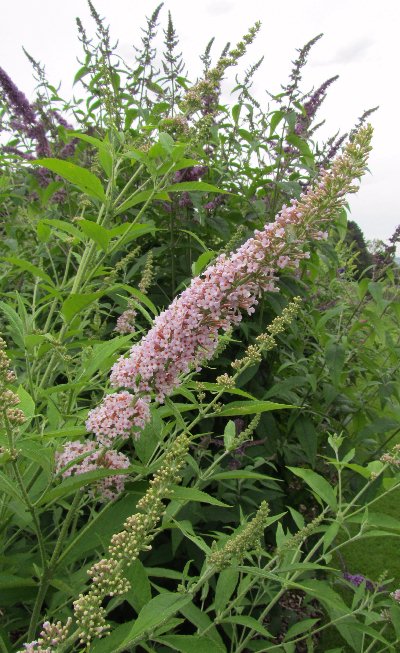
Les Kneale appeared much pinker at Longstock. | I thought I was familiar with B. davidii 'Les Kneale' but found that the Longstock specimens (they have two) were much pinker than my own (which has only the faintest hint of lilac) although clearly the same plant with narrow, erect panicles and paler foliage. It is unlikely to be due to soil conditions, rather that a 'Sport' has arisen during rounds of propagation. I can't say which is the orginal form that was found growing wild on the Isle of Mann. Leela Kapila is very much like Santana with the same maroon flowers but the leaves lack the darker green centres. It really stood out where it was growing at in the border and had a remarkable fluorescent quality to the foliage. Moonshine (see below) is similarly yellow-leaved but doesn't quite compare with Leela Kapila.
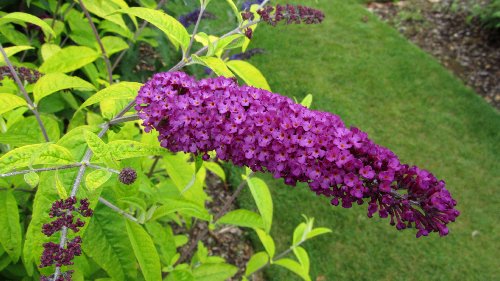
Leela Kapila has almost fluorescent foliage in the sun. |
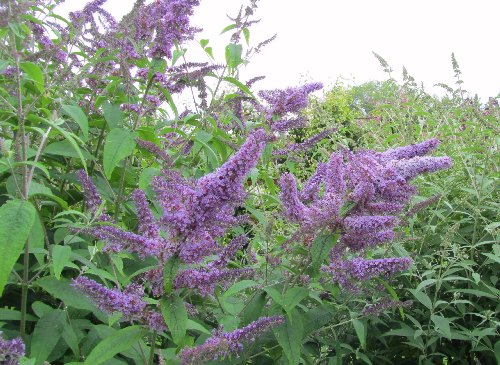
Greenways River Dart with many branched flowers. | Another B. davidii that grabbed my attention was Greenways River Dart, found growing in the garden of Agatha Christie's former home on the river of the same name. The flowers are branched in a similar way to Dartmoor, which is a messy and very vigourous cultivar with dirty pink-purple flowers. Greenways River Dart has nice pale blue to lilac flowers and is a neat upright shrub - surely a better bet than RHS AGM awarded Dartmoor. I have found that this flower type is more common in the wild than you would think. Panache also shares this trait which can be readily passed to the next generation. |
I have just started growing Buddleja nivea (see below) which has quite deep mauve flowers. Longstock also has a pink-flowered form, and the flowers are a very delicate pink indeed. This small shrub was growing outside quite happily so should be quite hardy. I also spotted B. nivea var. Yunnanensis, a huge subspecies several metres tall, three times the size of the usual B. nivea. |
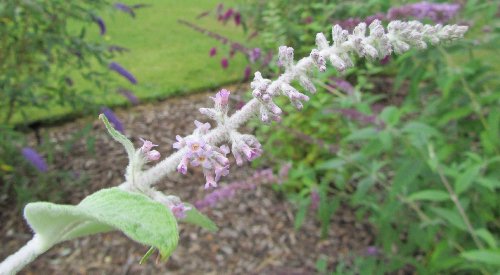
B. nivea Pink Form, much lighter flowers than the species. |
And finally B. albiflora, a fully hardy species not often grown. The small pale lilac flowers are not as showy as B. davidii but it still quite attractive and it has very interesting dark stems for such a pale flowered Buddleja. My thanks to Peter Moore for the invitation and taking the time to show me around. All photos this month taken at Longstock in the first week of August. |
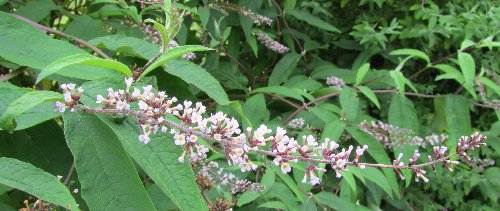
B. albiflora, not quite white just a delicate lilac. |
July 2012
It is getting repetitive but the weather once again dominates things: most of July has again been wet and cold. Finally, in this last week we have seen the big burning globe in the sky. Buddleja davidii flowers according to day length, so has starting flowering regardless of the weather but the recent sun helps. Those plants still with yellowish leaves can be turned green by extra feeding. Nitrogen in the form of Nitro Chalk (calcium nitrate) seems particularly effective. Yellowing can also be the result of magnesium and iron deficiency, but at the moment it is most likely poor nitrogen uptake from cold, wet and leached compost or soil. |
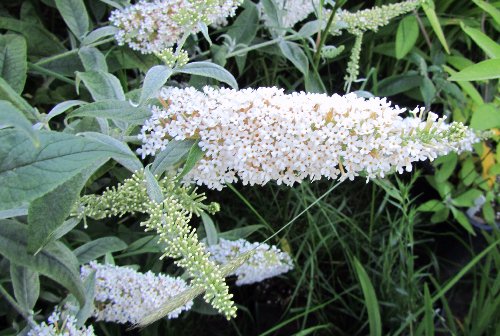
White Ball has pure white flowers. |
There has been a lot of interest recently in new super-dwarf Buddleja davidii cultivars and hybrids. Thompson and Morgan's Buzz series is widely promoted and the Lo and Behold Series of hybrids is also much feted. Both claim to be the first 'patio' Buddleja. Lo and Behold Blue Chip was the first released but as a complex hybrid doesn't really look much like a miniature Buddleja as most people would understand it. And apparently the Buzz series are growing well beyond their stated dimensions and are no longer being recommended by the Longstock Nursery (home of a national collection) as dwarf shrubs having seen theirs grow in excess of five foot (1.5m) this year. They may remain smaller confined to a small pot but their life expectancy will be severely curtailed. It seems that there has been an unnecessary rush to get these to market without sufficient trailing, although I must admit to liking these plants. Incidentally, White Ball was actually the first true dwarf hailing from Boskoop, Netherlands some years ago. |
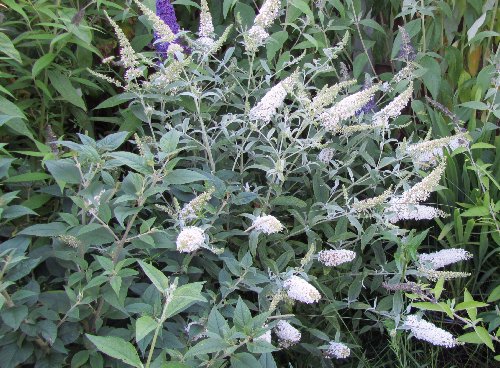
White Ball forms a very small (1 metre/3 foot) round shrub if correctly pruned in spring. |
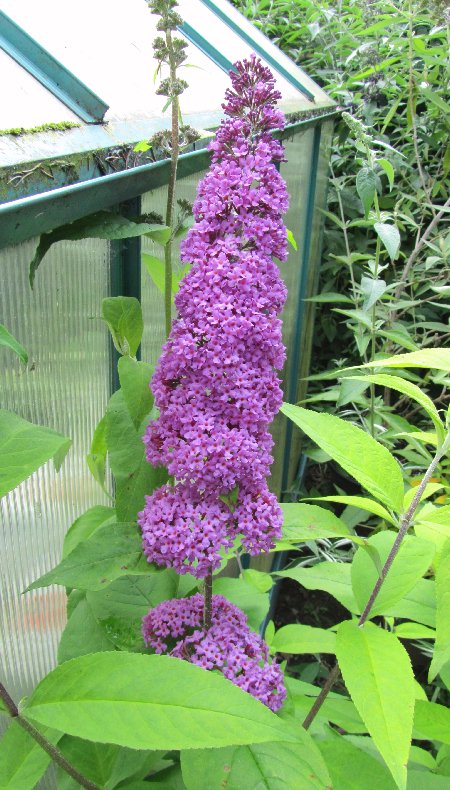
Moonshine's flowers contrast well with the pale foliage. | Flowering starts here and the pick so far must be Gulliver. Again it is described as having a dwarf habit but mine has grown to 6 foot plus (2 metres) in one year. But the flowers are enormous: huge, open clouds of lilac (sadly a rather basic, pastel colour). Now, getting this flower size and type in a variety of strong colours would really be something. Other standouts are Moonshine, Sugar Plum and Miss Ruby. Moonshine, you may remember, has lime-yellow foliage and its flowers are a really contrasting cerise. I may be wrong, but to me it looks like a foliage sport of Border Beauty, as the flower morphology as well as the colour are so similar. Sugar Plum and Miss Ruby share a similar red-pink shade but Miss Ruby has a conspicuous yellow eye which Sugar Plum lacks, making the latter appear much more red from a distance. They are both a striking colour which Buzz Red shares. |
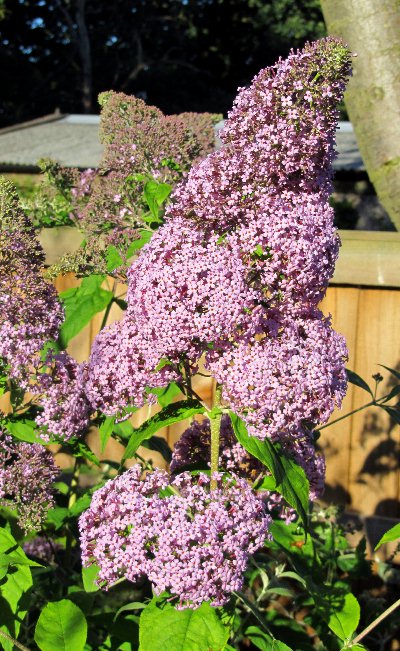
Gulliver has really big, lilac flowers. |
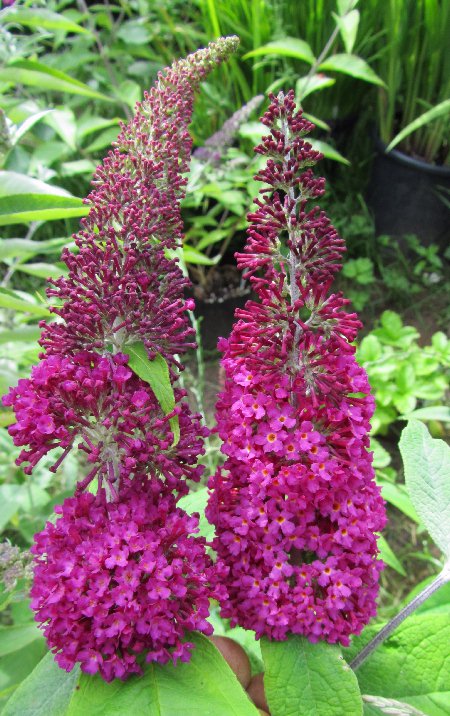
Sugar Plum (left) doesn't have the yellow eye of Miss Ruby (right) so appears more red from a distance. | A new species to me is Buddleja nivea, another Asian species described as hardy in the UK. There are several subspecies, but mine is the basic one and should grow to only 6 foot (2 metres). What distinguishes this species is the copious white fuzz (indumentum) that covers the stems and the softest felted leaves of any Buddleja. Many think the flowers are uninteresting and that it is really a foliage plant, but I disagree. It produces long cat's-tail panicles of mauve flowers (there is also a pink sub-species) with a large orange eye that is only apparent close to. There is a slight, but unusual scent.
|
June 2012
The weather through June has been truly terrible. Buddleja davidii is a tough old plant and most established plants are now showing their flower buds although they are unlikely to open much before July. Some of the cultivars have a hint of yellow in their new leaves because temperatures have been so low. This is more pronounced in potted and young plants but they will soon green-up once the sun returns. The prize for the first Buddleja davidii flower of the year goes to Buzz Red which is a truly remarkable rich cerise, although I cheated by keeping this plant under cover. |
|
|
One pest that can attack Buddleja davidii is the nematode, or eelworm. The symptoms are stunted and deformed foliage as well as damaged buds. This shouldn't be mistaken for the quite normal habit of several cultivars, notably 'White Ball', to produce misshapen growing tips as a consequence of the congested growth habit. |
Other species are fully in flower now although these are all later than last year. Buddleja globosa is a vigorous shrub and a reliable bloomer. The little orange golf-balls are much beloved by the bumblebees which often spend the night asleep on the flowers where they have been feeding. There are a few named varieties but all are a similar orange, even 'Lemon Ball' which is barely a shade lighter. The one exception is named, snappily, HCM98017 and has pale greenish yellow flowers. Although unique the flowers don't stand out against the stems and green foliage which is slightly paler than the species. Buddleja alternifolia is another early summer flowering species. Both these species will grow into very large shrubs and the best time to prune (if you actually need to contain them) is straight after they flower.
.

HCM98017 is a very different shade to the average Buddleja globosa |
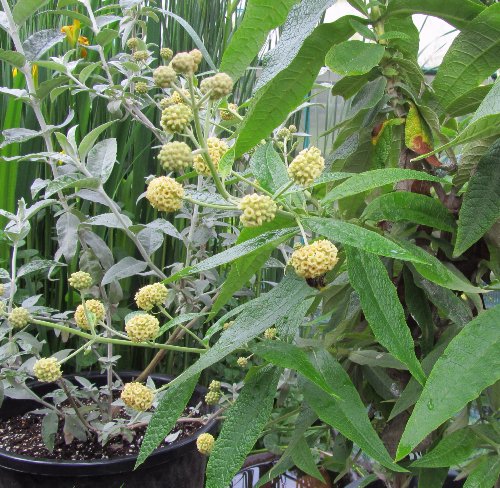
Buddleja globosa HCM98017 has pale yellow flowers that don't stand out. |
|
Buddleja loricata, otherwise called Mountain Sagewood in its native South Africa, is also in flower now. When a plant normally shy to bloom produces copious buds this is often a sign that something is wrong: one last attempt to reproduce before hanging up its roots for the final time. Sadly, my species Buddleja colvilei produced bright pink flowers just before wilting and dying. It looks like the roots had failed to re-establish after the winter and I don't really know whether the cold and wet, insect damage or fungal infection were to blame. Growing more exotic Buddlejas is less certain than growing the common species and you must always be prepared for the odd failure even when you have really pampered the plant. Fingers crossed that the cuttings I took as soon as the problem was spotted are successful. |
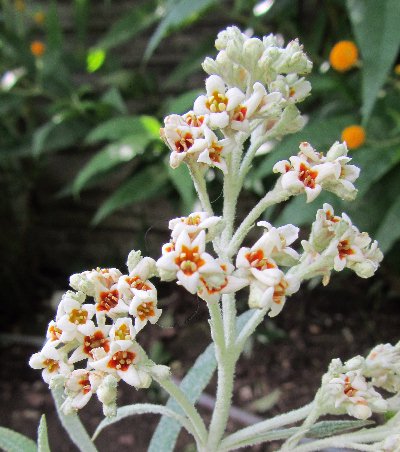
Buddleja loricata has bloomed at the wrong end of the season. |
| |
May 2012
|
A really cold April and early May with constant rain has been followed by excellent weather at the end of the month. Some of the species Buddlejas outside will be flowering a little later than usual so we will have to look at those next month. Plants lucky enough to be under cover have, however, been able to get on with their business. The South African B.glomerata, otherwise known as Karoo Sagewood, has fluffy yellow flowers with a spicy clove scent. Not keen on wet, this one, so it could have suffered without the protection of a greenhouse. From the same country B.salviifolia (African Sagewood) has also flowered, a month after the 'alba' variant (see below, April). This is the first time I have seen my plant flower and I am really pleased with the large blue flower panicles. The strong scent is much like its 'Alba' cousin but a touch more refined and attracts bees from miles around. Both B.salviifolia forms need hard pruning immediately after they flower to ensure healthy, vigorous growth for next year's display. This is even more imperative when they are grown in pots to avoid creating skeletal, woody specimens.
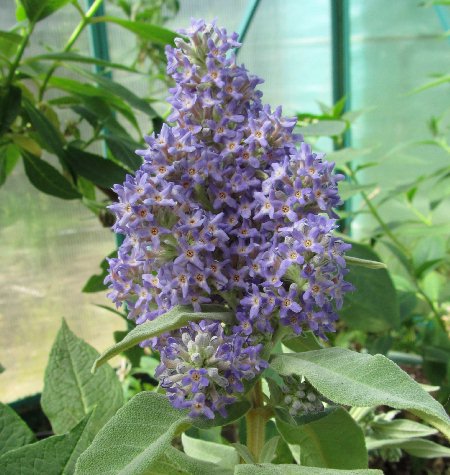
Buddleja salviifolia is a fetching blue with a strong scent. |
|
| The rich red flowers of B.covilei 'Kewensis' come early under cover but this plant is destined to go outside for next winter. Allegedly it is more hardy than the pink species, which has yet to flower outside, although the latter has copious buds forming thanks to a mild winter and fleece protection (see below, January). |
A few B.davidii cultivars suffered frost damage in April where they had put on soft growth in March. They are recovering fast now and all are growing well again. Burncross, a new small, variegated cultivar has grown a completely white shoot, a phenomenon I have also seen with Variegata. As it has no functional chloroplasts it is a complete parasite and should be removed. I have been able to clear my windowsills of Buddleja seedlings, which are now ready to be potted on and put outside. If you would like advice on growing from seed click HERE. |
|
April 2012
April is a month when things start really happening with Buddlejas. The deciduous species come back into leaf and the recently pruned plants such as B. davidii really begin to put on growth. The first flowers are now open, at least in a cool greenhouse. Buddleja salviifolia var. alba has been the first to flower from stalled buds formed last autumn (see below). This was a new plant I had last year and it has grown fast in a 25 litre pot. With huge panicles of creamy white flowers with a rather cloying scent it has flowered weeks ahead of the more common lilac or blue variety. Buddleja sterniana has also flowered. It is a deciduous species that can lose its flower buds outside so I keep a small spare under cover. It is a B. crispa subspecies and shares features such as its felted, toothed foliage with the related B. crispa subspecies B. farreri and B. agathosma. Both these are larger than B. sterniana with larger leaves, those of B. agathosma being up to a foot long. All have delicate pinky lilac flowers in spring, often on nearly bare branches. If you must prune any of these it should be immediately after flowering to allow the shrub to regenerate fully and produce flower buds before winter, although often they are hit hard by frost so it is sometimes a case of just cutting away dead wood.
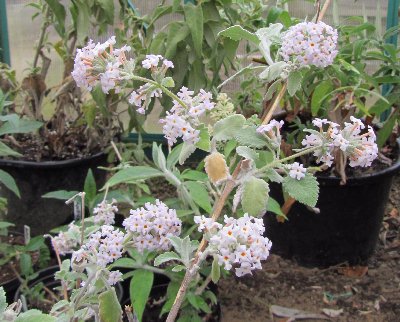
Buddleja sterniana has pretty, delicate pink flowers with a very pleasant scent. |
|
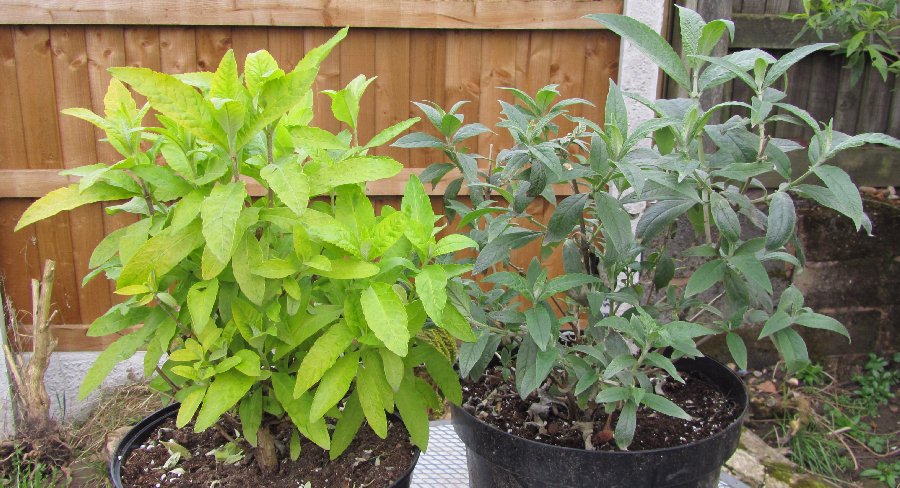
Moonshine (left) has very unusual foliage compared to a normal Buddleja davidii cultivar (right). | |
New B. davidii cultivar Moonshine has remarkable greeny-golden foliage now which will possibly darken to more of a lime green later in the season. There are other cultivars with yellow foliage such as Golden Sovereign, an American sport of Empire Blue, and Leela Kapila which resembles Santana except for having very little green in the leaves. April is one of the best times to take cuttings especially from those species that flower later on in the year. The April rain means the plants are turgid (the tissues are fully hydrated) and the shoots are at an ideal stage to root. Advice on taking Buddleja cuttings can be found here. |
|
March 2012
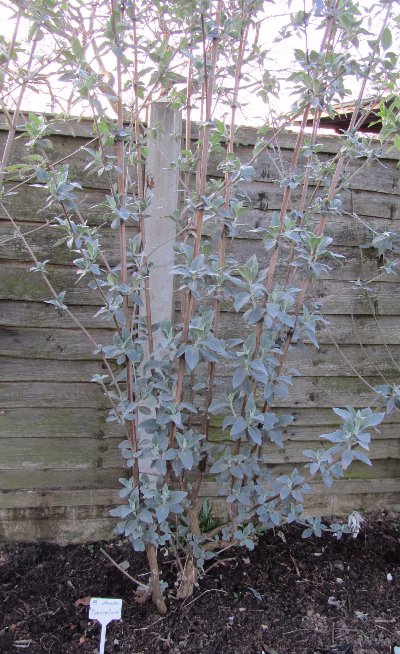
This three-year old Persephone plant has plenty of new shoots low down and is growing fast already. It was deadheaded and slightly reduced in height last autumn. |
|
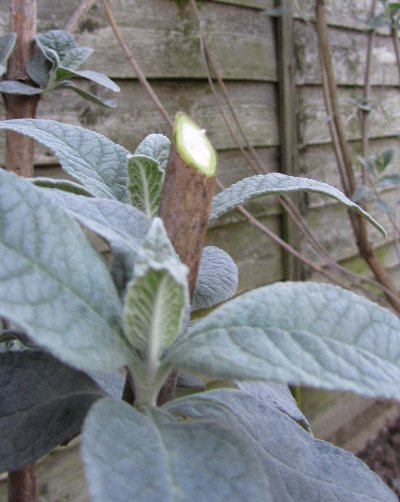
Cut at an angle a little above a new shoot. |
|
|
After pruning always feed the plant. B. davidii uses the small winter foliage as a storage organ for nutrients, particularly nitrogen, so pruning depletes its reserves. Mulch the base with garden compost (add a little lime to avoid excess acidity), mushroom compost or spent potting compost. Feed with a high potash, slow release compound fertiliser, preferably one that includes trace elements, by top dressing (mix it into the surface of the mulch). Only a couple of handfuls will greatly improve vigour and bloom quality. |
|
|
|
February 2012
|
The winter came for a whole week in February but caused relatively little damage compared to last year's very harsh cold. There are far fewer winter casualties this year. February is a waiting month. It is far too early to prune summer flowering species or to plant out. Pruning now could kill even established Buddlejas if the weather turns wet and nasty again. The danger is rot getting into the trunk or wet roots dying because there is no transpiration area (leaves) available to keep the root tissues' moisture balance.
Next month is pruning month for B.davidii cultivars and other late summer flowering species (I'll have more to say about pruning then): late March here in the Midlands, possibly earlier further south and maybe best left until April in colder areas of the UK. The only job now is sowing seeds saved from last year. A heated propagator on a windowsill is the best equipment for the job. It is early but sowing now gives a reasonable chance of first year flowering. It can be tricky indoors to keep the seedlings from becoming weak and leggy leading to damping off. Many cultivars are showing excellent foliage at the moment. Persephone, Ellen's Blue and Lochinch have particularly silvery foliage at the moment that sadly will be pruned away next month. Lochinch, with its B.fallowiana parentage, normally looses most of its leaves but the mild winter has allowed it to produce the excellent foliage shown right. |
|
|
New CultivarsThere have been quite a number of new cultivars hitting the garden centres and mail-order companies recently. Moonshine (Buddma PBR) is a new floriferous dwarf from Holland described as having pink-purple flowers and lime-green to yellow foliage, which is its main selling point. It comes from Plantipp Nurseries who are also growing a number (five) of the USA Podaras Flutterby dwarf hybrids under the trade-name Buddleja davidii Free Petite Blue Heaven, Dark Pink, Snow White, Lavender and Tutti Fruitti. All are complex hybrids believed to be sterile or near sterile. Burncross from Blooms is another recent introduction with variegated foliage and pale blue-violet flowers. This promises to be a true dwarf version of Variegata, as did the variegated cultivar Florence (which is not dwarf at all). Buddleja Buzz Velvet, also called Buzz Red in Europe, is a sixth addition to the Buzz range of ultra-mini Buddlejas. This purports to have deeper red flowers than Buzz Magenta, perhaps closer to the richness of Royal Red. It is currently available as plug plants from several sources including Thompson and Morgan, the originators of the Buzz series. Thompson and Morgan have another new introduction in their Alan Titchmarsh Collection. Colour Fountain Blue is described as small, non-invasive Buddleja with long, lavender-blue flowers. I am hoping to review these two later in the year. There is one claim in common for all these cultivars - diminutive stature. It is good to see Buddlejas being bred only a metre in height but there isn't anything intrinsically wrong larger cultivars, and for many gardens a two metre (i.e.: fence height) shrub is ideal. A neat upright growth habit is perhaps a more desirable attribute than dwarfism. Possibly this obsession with miniature patio plants will eventually pass. |
January 2012
We have finally had a few hard frosts and below freezing temperatures. Deciduous species like B. alternifolia are reduced to twigs but with plenty of buds visible. Unlike B. alternifolia many of the species we grow are not normally deciduous in their native habitat but adapt to our harsher climate. One such is B. colvilei (not the 'Kewensis' cultivar), a species that can lose all its leaves in winter and be cut back quite badly by the cold. This year I am trying fleece to protect it; last year it was cut almost to the ground in the harsh winter and I had no flowers. It was a miracle it survived at all and this was probably because I had lined the raised bed in which it grows with a layer of bubble-wrap. It has been mild this winter but the fleece seems to be working and it still has many leaves. The only downside is that it also protects the earwigs and they have continued to chew holes in the leaves.
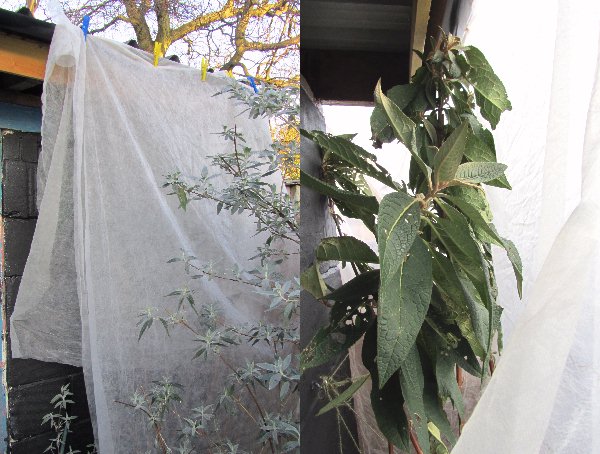
Ugly but effective! B. colvilei can lose its foliage in winter but the fleece seems to be working. Sadly it protects the earwigs, too. Many spring-flowering species form their flower bud the previous autumn. B. salviifolia, B. crispa var. sterniana and B. crispa var. farreri all do this and it can be diffcult to protect the buds outside. I am keeping B. salviifolia var. alba under cover for this reason. The flowers buds have not developed any further in the last two months but should be spectacular come the spring. |
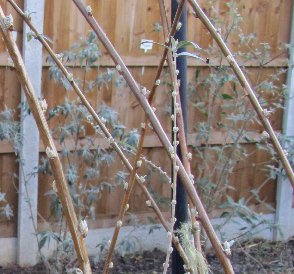
B. alternifolia loses its foliage but the buds promise flowers next May.
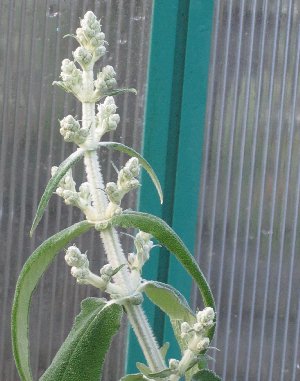
B. salviifolia var. alba's flower buds have stalled completely for two months but should open in the spring. |
As there is not much happening in January I thought I would draw your attention to an interesting story about feral Buddlejas. Croxley Green in Hertfordshire gained protected status as a designated Village Green for 30 acres of abandoned land belonging to London Underground. The land, between a canal and the railway tracks, had been used as tip by the Undeground for all sorts of rubble and used railway ballast. As a pioneer B. davidii colonised this wasteland where nothing else could thrive and slowly a wildlife oasis has formed. During twenty years of abandonment this former tip has become a local amenity and the locals successfully fought a plan to develop the land by London Underground. The Buddlejas are now protected by law as a they fall within the new Village Green. What caught my eye about this was an interesting observation: native trees have started invading the Buddleja area and the Buddleja numbers are reducing. Rather than being invasive B. davidii is a coloniser which has facilitated later colonisation by native species which will eventually out compete it. I can't comment on the problems they have with Buddleja in New Zealand but here in the UK it appears that it may be an effective tool for the repairing the environment of brown-field sites. | |
December 2011
The frosts have started and many of the deciduous species are finally dropping their leaves after the mild autumn. This December still looks like being much milder than last year. As usual, B.weyeriana Honeycomb is the last flower of all. Many B.davidii cultivars are only semi-deciduous and produce especailly adapted leaves for the winter. The best plants have spectacular silver foliage this time of year, such as West Hill, a hardy hybrid of B.fallowiana and B.davidii. White Ball is one of the smallest cultivars and has fine, uniform grey-blue foliage in winter. Variegata (also called Florence) has small winter leaves which are more deeply variegated than in the summer, many are almost completely cream. It is probable that the winter leaves are not concerned with much photosynthesis during the short days and serve other functions such as storage, respiration and transpiration.
|
|
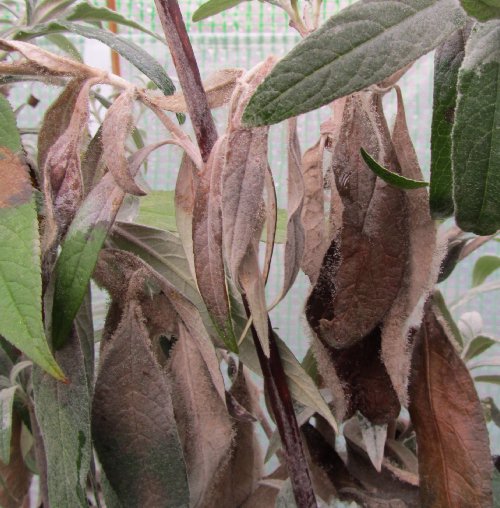
Botrytis or Grey Mould is a real danger for young plants or exotic species under cover. | The biggest threat in the mild but damp conditions is Botrytis fungus, commonly called Grey Mould. This is a particular problem under cover where there is limited air-flow. It will initially go for dying summer leaves but can quickly get a hold in any soft plant tissue. As it spreads it will kill the winter leaves, the lateral buds and even the stems, eventually weakening and killing plants. Exotic evergreen species are most prone but even tougher Buddlejas can suffer. Advice is usually to keep greenhouse well ventilated opening the doors and windows on milder days. The only other thing that helps is to daily remove the leaves and parts that have been affected to slow the spread and limit the number of spores in the air. |
November 2011
|
There are just one or two B.davidii and B. x weyeriana flowers left in November and these will be gone once the frosts begin in earnest. By now I have mostly dead-headed these plants and reduced their height slightly to guard against wind-rock. The seed heads I have spared are maturing and ready to bring in to dry for sowing next February. The more delicate species Buddlejas and small seedlings have been moved into a greenhouse or polytunnel for protection. These can usually take the cold but need to be kept on the dry side. It's the combination of wet soil that freezes that is so lethal in pot grown plants. They are also prone to grey mould so I am trying to open the door on dry days to ventilate and keep down the damp. | ||
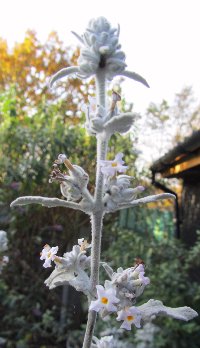
B. crispa var. sterniana should flower in spring but they are opening now. | A mild autumn can play havoc with the flowering mechanism of the more exotic Buddleja species and hybrids. Buddleja crispa var. sterniana is a case in point. It should flower in the early spring, around mid-march, forming the buds the previous autumn. Our harsh winters have been cutting the plant back and typically all the flower buds are lost unless protected. The exceptional warmth in October followed by the mild November has caused the flower buds to begin opening now, which is a nice surprise. The hybrid Salmon Spheres is listed as flowering once each year in May/June, the same time as its parent B. globosa. My plants haven't stopped all summer and, having moved them under cover, a few flowers are still open. Even though sterile regular dead-heading seems to encourage this continuous succession. I have noticed that the flowers on Salmon Spheres are different colours according to the time of year. In summer they are much more pink but in the cooler autumn months they tend to be more peachy, even yellow. |
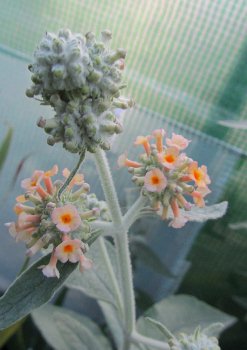
Buddleja Salmon Spheres just doesn't know when to stop flowering. |
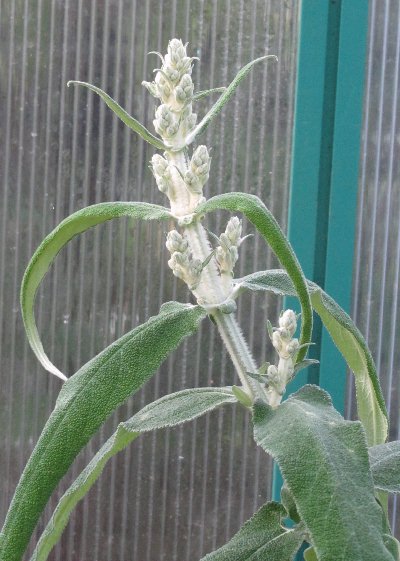
B. salviifolia var. alba has buds now but when will they open? | My B. salviifolia var. alba is an unusual variant on the species with very different foliage; the common B. salviifolia from South Africa can have blue, lilac or white flowers. I haven't seen this one flower yet but I believe the large white plumes open in spring and are also somewhat different to the species. From trawling round the internet this form seems to be more prevalent in Northern South Africa up to Zambia, so could be too delicate for planting outside. The photo on the left shows the buds which have formed this autumn. They show no sign of opening yet like B. sterniana above and I have my fingers crossed that they will be able to over winter in a cold greenhouse. I am reliably informed by Nick Macer at Pan-Global Plants (where it came from) that the buds will stall and not open until spring. This stalling of flower buds also happens in B. officinalis which has now formed a number of flower buds at the end of each stem. These could open any time over the winter or stay dormant until spring. I am keeping it inside to hopefully enjoy sweet-smelling Buddleja flowers at Christmas. |
RETURN TO THE HOMEPAGE | |
